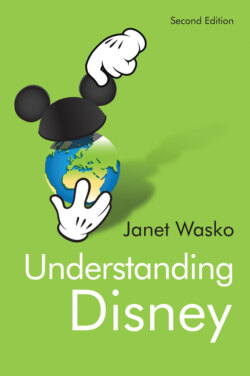Читать книгу Understanding Disney - Janet Wasko - Страница 18
Disney’s Folly
ОглавлениеThe Silly Symphonies set the stage for animated feature films, an innovation that was accompanied with the usual fanfare and praise for Walt’s foresight and ingenuity. As the official history tells us, “Walt Disney was never satisfied with what he had already accomplished.”34
Actual work on Snow White and the Seven Dwarfs, the company’s first animated feature, began in 1936, with an estimated budget of $150,000. By the time it was completed in 1937, the cost was $1.5 million. Before its release, the film was also known as “Disney’s Folly,” as many in the film industry were not convinced that audiences would sit through a feature-length cartoon. Nevertheless, by some accounts, Disney persevered primarily because he was convinced that the introduction of the double bill would eventually squeeze out short cartoons, and that the only profitable future for animation was in features that would attract more revenues.
Snow White was an immediate hit, setting attendance records around the United States, with box-office grosses of $8.5 million within its first three months of release. The film industry was pleased as well, awarding Disney a special Academy Award in 1939. The film was also reissued six times by 1983, with revenues increasing to $47 million. On its fiftieth anniversary release in 1987, the film attracted $40 million in fewer than eight weeks.
The merchandising and tie-in campaigns that accompanied the film may surprise those who think of such activities as a more recent Hollywood phenomenon. As early as 1936, the company granted more than 70 licenses to various companies to produce a wide range of items, including clothing, food, toys, books, phonograph records, and sheet music. Comic books, painting and coloring books, and picture books were sold before the film was released. Also featured were Snow White radios produced by Emerson, Snow White-print corsets, Snow White sliced bread, and Snow White treasure chests for all the Snow White toys. In fact, the merchandising campaign was noted as a “dramatic example of a new force in merchandising.”35 The multitude of products not only brought in revenues but importantly helped to publicize the film and build the Disney reputation.
While continuing to produce several cartoon series based on Mickey Mouse, Donald Duck, Pluto, and Goofy, the studio also worked on new animated features. Pinocchio and Fantasia were both released in 1940, followed by Dumbo (1941), The Reluctant Dragon (1941), and Bambi (1942).
